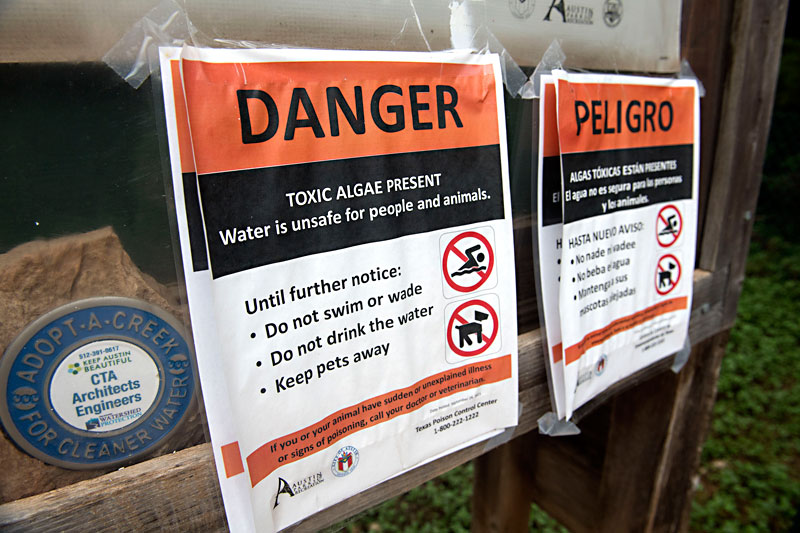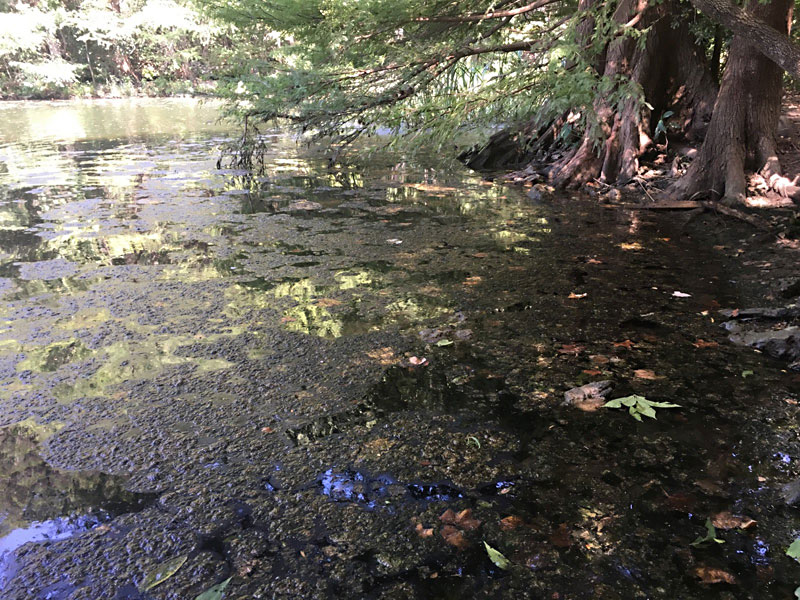Austin Pilots New Tactics to Address Toxic Algae Blooms
Toxin found in Sculpture Falls poses greater risk to humans
By Lina Fisher, Fri., Oct. 15, 2021

Toxic algae isn't new to Austin's waterways. In 2019, at least five dogs died as a result of ingesting a toxin produced by certain types of freshwater cyanobacteria, or blue-green algae, in Lady Bird Lake, followed by more harmful blooms the following year at Red Bud Isle and Festival Beach. Toxins have also been found across the Highland Lakes, including in Lake Travis and Lake Austin earlier this year.
Dogs appear particularly vulnerable to the toxins produced by these algae blooms, but a different type of algae neurotoxin that poses a greater risk to humans has now appeared in Austin. Last month, after receiving a report that a person had fallen ill after swimming in Barton Creek, the city found concerning levels of the cylindrospermopsin toxin in Barton Creek near the popular Sculpture Falls swimming hole. Unlike the earlier incidents, in which the toxin was detected in the algae itself, at Sculpture Falls the toxin had suffused the water, meaning there's a higher possibility of human exposure from recreational use. "People are unlikely to eat big handfuls of gross algae," said Brent Bellinger, a senior environmental scientist in the city's Watershed Protection Department, but "your average child swimming is probably gulping some water." For now, both people and pets are advised to not swim at Sculpture Falls.
Cylindrospermopsin, like the other neurotoxins found in Austin waterways – dihydroanatoxin and homoanatoxin-a – can cause nausea, diarrhea, headaches, and, with long-term exposure, internal organ failure. Toxins aren't always present, but algae is, particularly in warm stagnant water conditions, usually around June or July in Austin, while receding in the winter. The algae found in 2019 was here before, said Bellinger, but that year new "Goldilocks conditions" gave it the capacity to produce toxins. A change in nutrients, either caused by runoff from 2018's heavy rainfalls or the arrival of the dreaded zebra mussel, led to these conditions.
"I don't see it as a coincidence that within two years of zebra mussels coming into the system, we have toxic algae," Bellinger told the Chronicle. The mussels are a "human calamity," traveling from lake to lake by hitching rides on boats that haven't been properly cleaned, eating good phytoplankton that compete with toxic algae and excreting nutrients like phosphorus that lead to cyanobacteria growth. Boats aren't allowed in Sculpture Falls, so it remains unclear how the toxic algae arrived there.

The type of blooms happening in Austin – called benthic mats – are a lot less studied than other types of algae that affect larger bodies of water, explained Bellinger. Still, global observations are on the rise, finding "strong links to climate change, because of changes in our rainfall patterns." Droughts cause stagnant water, large rain events flush in unfamiliar nutrients and fertilizer runoff, and unseasonably warm temperatures lead to "the cyanobacteria [being] in their optimum environment for a longer period of time," said Bellinger.
Because the algae cycle is mostly predictable, monitoring can catch harmful blooms before anyone comes into contact with them. Bellinger and his team test toxin levels every other week in Lady Bird Lake, Lake Austin, and Lake Travis. Testing will decrease with the blooms, scaling back to monthly in the winter, barring a seasonal anomaly. The Lower Colorado River Authority, which monitors the Highland Lakes, strongly encourages people and pets to avoid contact with algae in any of the Highland Lakes after the agency received reports of several dogs becoming ill and one dog dying after swimming in Lake Travis in the weeks following Winter Storm Uri.
Earlier this summer, the city contracted with a company called EutroPhix for a 4- to 5-year pilot of a possible mitigation tactic through a clay product called Phoslock. Phosphorus in freshwater systems is a "limiting nutrient," meaning an excess leads to algae production. Phoslock buries the phosphorus, Bellinger explains. "It settles on the sediment surface, and binds the phosphate ions irreversibly. We're trying to speed up that process in the hopes that it'll starve out the cyanobacteria." Starting June 21, the city treated 21 acres of water around Red Bud Isle with a total of 120,000 pounds of Phoslock, collecting samples before and after three treatments. "The last sampling event, the data was looking pretty positive," said Bellinger.
But Phoslock is expensive: $300,000 for 2021 alone, including the material, application, and lab testing. Bellinger said the next phase will be going back out in the spring to check the levels of phosphorus compared to fall: "Do we still have a strong treatment effect? Can we add less around Red Bud next year, and maybe target another part of the reservoir? Or is there so much organic matter coming in that we have to keep adding a lot at Red Bud Isle? Which then makes this mitigation strategy not really feasible in the long-term. You want to push the system backwards, you don't want to run in place."
The goal is to be like Alice in Wonderland, said Bellinger. "Alice is running and running, and she's still not getting away from the Red Queen. We want to get away from the Red Queen – the Phoslock is what we're trying to help us do that.
"The hope is that over the course of the winter, with different rainfall events, the Red Queen is not getting closer to us."
Got something to say on the subject? Send a letter to the editor.









